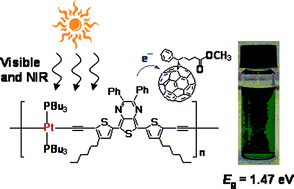The synthesis, characterization and photophysics of some solution-processable intensely coloured polyplatinynes functionalized with the thienopyrazine–thiophene hybrid spacer and their model molecular complexes are described. These metallated polymers possess extremely low bandgaps of 1.47–1.50 eV, which extend towards the near-infrared (NIR) range of the solar spectrum, and represent the lowest optical bandgaps ever reported for metallopolyynes in the literature. Both polymers can be used to fabricate efficient solar cells with power conversion efficiencies (PCEs) of up to 0.63% under air mass (AM1.5) simulated solar illumination, and the possibility of covering the 600–900 nm solar-radiation range to harvest photocurrent has been demonstrated. The influence of the thienyl core as well as its substituent group, on the optical and photovoltaic behavior of these metallopolymers was investigated in detail. The power dependencies of the solar cell parameters (including the short-circuit current density, open-circuit voltage, fill-factor and PCE) were also studied. The present work offers an attractive avenue towards conjugated materials with broad solar absorptions and demonstrates the potential of metallopolyynes for both visible and NIR light power generation.

You have access to this article
 Please wait while we load your content...
Something went wrong. Try again?
Please wait while we load your content...
Something went wrong. Try again?


 Please wait while we load your content...
Please wait while we load your content...